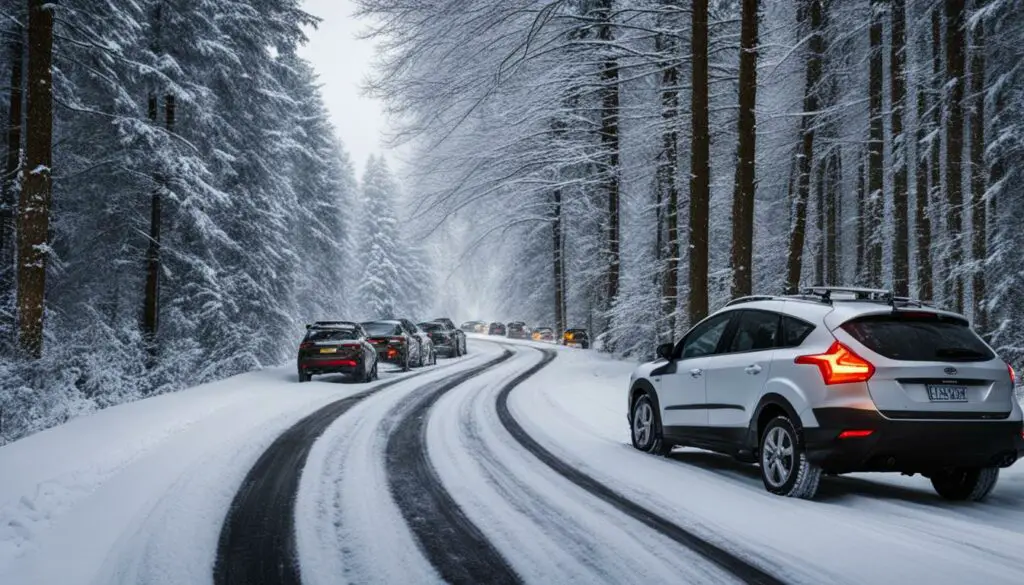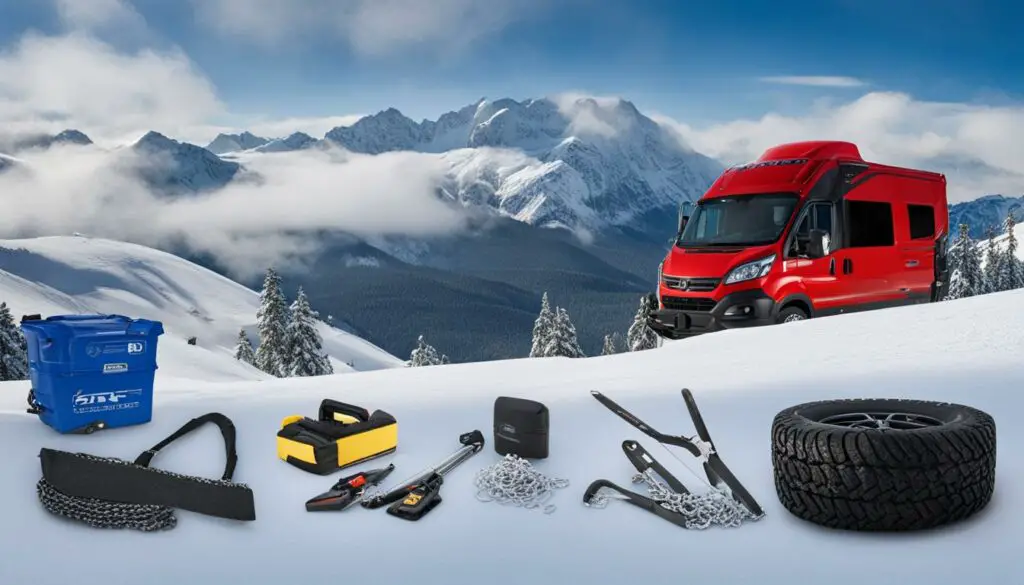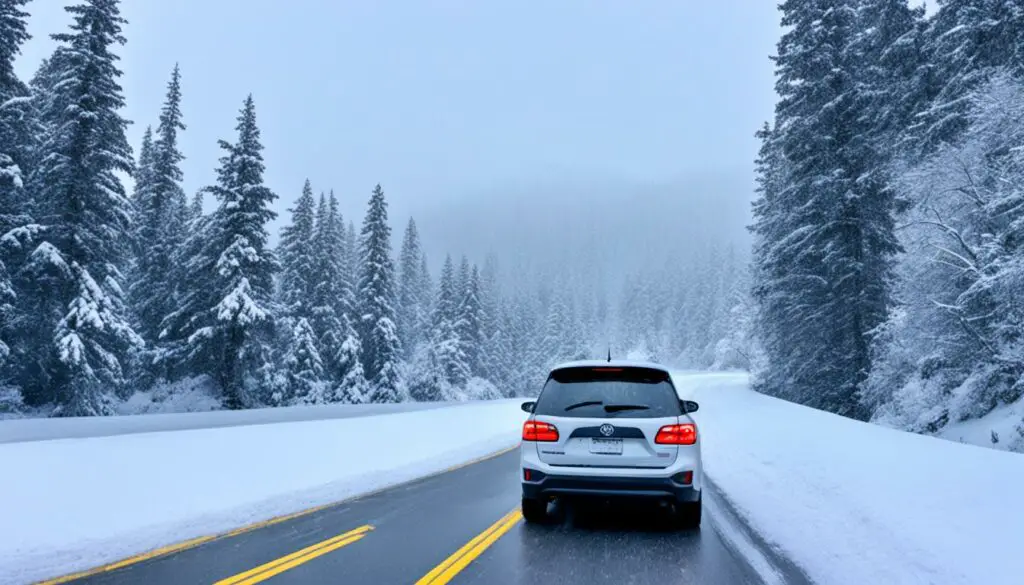Did you know that each year, millions of drivers in snowy and icy regions face the challenges of navigating treacherous road conditions? To help ensure safety on the roads, transportation authorities have implemented a system called R1 Chain Control. This set of regulations and requirements is specifically designed to enhance traction and prevent accidents in winter weather. Let’s take a closer look at what R1 Chain Control entails and how it impacts drivers.

Key Takeaways:
- R1 Chain Control is a system of regulations and requirements for winter driving in snowy and icy conditions.
- It mandates the use of tire chains or traction devices on certain vehicles to improve traction and prevent accidents.
- R1 Chain Control is typically imposed in areas with heavy snowfall or slippery road conditions.
- Violating R1 Chain Control regulations can result in fines and penalties.
- Understanding the specifics of R1 Chain Control is crucial for drivers who frequently travel in winter weather.
Understanding R1 Chain Control Requirements
R1 Chain Control is a set of regulations and requirements that drivers must adhere to when traveling in areas with snowy or icy road conditions. It entails specific guidelines for the use of tire chains or traction devices to ensure maximum traction and minimize the risk of accidents. Understanding the R1 Chain Control requirements is crucial for drivers who frequently navigate winter weather conditions.
What is R1 Chain Control and Why Does It Matter?
R1 Chain Control refers to the level of chain requirement imposed by transportation authorities. It indicates that all vehicles, except passenger vehicles and light-duty trucks under 6,000 pounds equipped with snow tires, must have chains on their tires. However, snow tires are still mandated to be installed on at least two drive wheels to enhance traction.
Definition and Legal Implications
R1 Chain Control is implemented in areas with heavy snowfall or slippery road conditions to ensure road safety. By enforcing the use of chains or traction devices on vehicles, it strives to reduce the occurrence of accidents and improve driving conditions. Violating R1 Chain Control regulations can lead to fines and penalties, as imposed by transportation authorities.
Chain Installation Process
The installation process for R1 Chain Control involves properly securing chains on the tires of vehicles. Drivers are required to follow the manufacturer’s instructions and ensure that the chains are tightly fitted and evenly aligned on the tires. Adequate chain tension is necessary to maintain proper traction on snowy or icy roads.
Areas Where R1 Chain Control is Imposed
R1 Chain Control is typically imposed in regions that experience heavy snowfall or slippery road conditions. Areas commonly affected by R1 Chain Control include mountainous regions, high-altitude highways, and areas prone to winter weather phenomena. It is essential for drivers to stay informed about the specific areas where R1 Chain Control is in effect to ensure compliance and safer driving.
You might also like: What are SAE Class S Tire Chains and When to Use Them?
Essential Equipment for R1 Chain Control
To comply with R1 Chain Control requirements, drivers need to equip their vehicles with the necessary tools and equipment. The primary equipment includes snow tire chains and traction devices. These essential items are designed to improve traction on snowy and icy roads, ensuring safer travel in challenging winter conditions.

Type of Chains and Traction Devices
When it comes to R1 Chain Control, there are various types of chains and traction devices available in the market. The most commonly used are traditional tire chains and alternative solutions like snow cables or tire socks. Each type has its own advantages and installation methods, so it’s important to choose the one that best suits your vehicle and driving conditions.
Vehicle Specifications and Exemptions
It is essential to consider your vehicle’s specifications and any exemptions from R1 Chain Control requirements. In general, passenger vehicles and light-duty trucks under 6,000 pounds equipped with snow tires on at least two drive wheels are exempt from using tire chains. However, it’s still important to carry chains and be prepared to install them if weather conditions deteriorate.
R1 Chain Control and Winter Driving Safety
R1 Chain Control plays a crucial role in promoting winter driving safety. The requirements and regulations aim to enhance traction and minimize the risk of accidents in snowy and icy conditions. By installing tire chains or traction devices, drivers can significantly improve their vehicle’s grip on the road, reducing the chances of skidding and losing control.
Driving safely in R1 Chain Control conditions is essential for both the driver’s safety and the safety of others on the road. Here are some winter driving tips to follow when R1 Chain Control is in effect:
- Reduce your speed and leave extra space between your vehicle and the vehicle in front of you.
- Accelerate and decelerate slowly to avoid skidding.
- Use your headlights to improve visibility and make your vehicle more visible to other drivers.
- Avoid abrupt steering maneuvers to maintain control of your vehicle.
- Stay alert and focused on the road, avoiding distractions.
- Monitor weather and road conditions before and during your journey.
- Check your tires regularly for proper inflation and tread depth.
- Keep an emergency kit in your vehicle, including items such as a flashlight, first aid supplies, and water.
Following these winter driving tips can help ensure a safer driving experience in R1 Chain Control conditions. Remember to always prioritize safety and be cautious when driving in snowy and icy conditions.
Must check: Top 10 Best Tire Chain Brands (Snow, Ice, Performance)
The Role of Caltrans and CHP in R1 Chain Control
Caltrans and the California Highway Patrol (CHP) play essential roles in the implementation and enforcement of R1 Chain Control regulations. As part of their responsibilities, Caltrans and CHP work together to ensure the safety of motorists and maintain the smooth flow of traffic during winter weather conditions.
Regulatory Authority and Enforcement
Caltrans, also known as the California Department of Transportation, holds the regulatory authority for R1 Chain Control. They determine when R1 Chain Control regulations are necessary based on weather forecasts, road conditions, and other relevant factors.
Caltrans is responsible for establishing and communicating R1 Chain Control requirements, such as the areas where chain installation is mandatory and the types of vehicles exempt from the regulations.

The California Highway Patrol (CHP), on the other hand, is responsible for enforcing R1 Chain Control regulations. CHP officers patrol the roads and ensure that motorists comply with the chain installation requirements in R1 Chain Control areas. They conduct inspections and may issue citations to drivers who fail to meet the necessary chain control standards.
How to Find Updated Information About R1 Control Zones
To stay updated on R1 Control zones and ensure compliance with the regulations, it is crucial to check for the latest information provided by Caltrans and CHP. Here are some recommended sources to obtain the most reliable and up-to-date information:
- Caltrans Website: Visit the official Caltrans website for the latest updates on R1 Chain Control areas and requirements. Look for dedicated web pages or sections that specifically address chain control and winter driving conditions in your region.
- CHP Websites and Social Media Channels: Stay connected with your local CHP division by visiting their official websites and following their social media channels. They often post timely updates on chain control requirements, road closures, and other vital information for drivers.
- Road Condition Hotline: Utilize the Caltrans Road Condition Hotline to access real-time information about R1 Control zones and other road-related updates. The hotline provides valuable details on current road conditions, closures, and restrictions, including R1 Chain Control locations.
By regularly checking these sources and staying proactive in gathering information, drivers can stay well-informed about R1 Chain Control zones and ensure a safe and compliant journey.
What Does R1 Chain Control Mean for Different Vehicles?
R1 Chain Control imposes specific requirements and regulations that vary based on the type of vehicle. For passenger vehicles and light-duty trucks under 6,000 pounds equipped with snow tires on at least two drive wheels, chains are not mandatory. However, carrying chains and installing them when required is still necessary.
In the world of winter driving, understanding the various chain control designations is crucial for safely navigating snowy and icy roads. One such designation is R1 chain control, which refers to the winter driving restrictions for different vehicles. So, what does R1 chain control mean?
For light-duty trucks under 6,000 pounds that are equipped with snow tires on at least two drive wheels, chains are not mandatory under R1 chain control. However, it is still important to carry chains and install them when required by road conditions. This means that even if your vehicle meets the criteria for exemption from mandatory chain usage, it’s always a good idea to have chains on standby for when conditions worsen.

R1 for chain control acknowledges that certain vehicles have better traction capabilities with snow tires, hence the exemption from mandatory chains. However, it’s important to note that this exemption does not guarantee unlimited traction on snow and ice. It is still vital to exercise caution and drive at appropriate speeds when winter conditions are present.
Must check: Michelin Easy Grip vs AutoSock Snow Socks: Which Offers Better Snow Traction?
How to Properly Equip Your Vehicle for R1 Conditions
Equipping your vehicle for R1 Chain Control is essential to ensure safe travel in snowy and icy conditions. This involves choosing the right chains or traction devices and properly installing and using them. Here are some important considerations to keep in mind:
Choosing the Right Chains or Traction Devices
When selecting chains or traction devices for R1 conditions, it’s crucial to choose ones that are specifically designed for snow and ice. Look for chains that are compatible with your vehicle’s tire size and follow the manufacturer’s recommendations. Opting for high-quality chains or traction devices will provide better traction and durability, ensuring a safer driving experience.
Installation and Use of Tire Chains
Proper installation is key to ensure that tire chains or traction devices are effective. Before installing the chains, refer to your vehicle’s manual for any specific instructions and precautions. Make sure to install the chains on the designated drive wheels, which are typically the front wheels for front-wheel drive vehicles and the rear wheels for rear-wheel drive vehicles.
Tip: Practice installing the chains beforehand in a safe and controlled environment to familiarize yourself with the process. This will help ensure a quicker and more efficient installation when you encounter R1 Chain Control conditions on the road.
Once the chains are properly installed, it’s important to adjust their tension according to the manufacturer’s guidelines. Check the tension periodically during your trip to ensure that the chains remain secure and tight. Remember to drive at a safe and appropriate speed while using tire chains, as excessive speed can cause damage to both the chains and your vehicle.
Be mindful of the road conditions and remove the chains as soon as they are no longer needed. Continuously driving with chains on dry pavement can lead to excessive wear on the tires and chains, reducing their lifespan and effectiveness.
Properly equipping your vehicle for R1 conditions by choosing the right chains or traction devices and correctly installing and using them will greatly enhance your safety and traction on snowy and icy roads.
R1 Chain Control vs. R2 and R3 Levels
R1 Chain Control is one of the three levels of chain requirements implemented in California. Understanding the differences between R1, R2, and R3 levels is crucial for drivers to comply with the appropriate regulations.
The table below provides a comparison of the restrictions and requirements of R1, R2, and R3 chain control:
| R1 Chain Control | R2 Chain Control | R3 Chain Control | |
|---|---|---|---|
| Vehicle Types | All vehicles (except passenger vehicles and light-duty trucks under 6,000 pounds with snow tires) | All vehicles (except those with 4-wheel drive or all-wheel drive) | All vehicles |
| Required Equipment | Tire chains on all tires (except passenger vehicles and light-duty trucks under 6,000 pounds with snow tires) | Tire chains on all tires | Tire chains on all tires |
| Minimum Snow Tire Requirement | Snow tires on at least two drive wheels | Snow tires on all tires | Snow tires on all tires |
As the table illustrates, R1 Chain Control imposes the highest level of restrictions and requirements compared to R2 and R3 levels. It mandates tire chains on all tires for all vehicles, except passenger vehicles and light-duty trucks under 6,000 pounds with snow tires.
Penalties for Ignoring R1 Chain Control Regulations
Non-compliance with R1 Chain Control regulations can have serious consequences, including penalties and fines. The California Highway Patrol (CHP) is responsible for enforcing these regulations and issuing citations to drivers who fail to comply. It is essential for drivers to understand and adhere to R1 Chain Control requirements to ensure their safety and avoid legal consequences.
| Violation | Penalty |
|---|---|
| Driving without tire chains or traction devices in designated R1 Chain Control areas | Fine of up to $500 |
| Inadequate installation or use of tire chains or traction devices | Fine of up to $250 |
| Failure to carry chains when required, even if not installed | Fine of up to $250 |
| Blocking traffic or causing accidents due to non-compliance | Fine of up to $1,000 and potential liability for damages |
These fines and penalties emphasize the importance of following R1 Chain Control regulations to ensure the safety of oneself and others on the road. It is crucial to properly install and use tire chains or traction devices when required, carry them as instructed, and drive responsibly in R1 Chain Control areas.
Preparing for R1 Chain Control Before Your Trip
Proper preparation is key to safely navigating R1 Chain Control conditions. Drivers should take steps to stay informed about road conditions and plan their trips accordingly.
Checking Road Conditions and Chain Control Updates
Before embarking on your trip, it’s crucial to check the current road conditions and the status of R1 Chain Control. Stay updated on weather forecasts, road closures, and any advisories or warnings issued by the transportation authorities. This information can help you assess the level of risk and plan your journey accordingly.
Tips for Safe Driving in R1 Chain Control Conditions
When driving in R1 Chain Control conditions, it’s essential to prioritize safety and take the necessary precautions. Here are some tips to help you navigate the roads safely:
- Reduce your speed and maintain a safe following distance from other vehicles.
- Accelerate and decelerate slowly to avoid skidding or losing control.
- Anticipate turns and allow for more time to stop.
- Avoid sudden braking or accelerating.
- Use your headlights to improve visibility and make your vehicle more visible to others.
- Avoid unnecessary lane changes and abrupt maneuvers.
- Stay focused and avoid distractions while driving in challenging conditions.
- Keep an emergency kit with essential items in your vehicle, including a shovel, ice scraper, flashlight, blankets, and snacks.
By following these safety tips and staying vigilant on the road, you can minimize the risk of accidents and ensure your own safety as well as the safety of other road users.
Final Thoughts on What is R1 Chain Control and How Does it Affect You?
R1 Chain Control is a vital component of ensuring winter driving safety in areas with snowy and icy road conditions. By understanding and adhering to R1 Chain Control requirements, drivers can significantly enhance traction and minimize the risk of accidents on the road.
Remember, R1 Chain Control mandates the use of tire chains or traction devices on certain vehicles, except for passenger vehicles and light-duty trucks under 6,000 pounds with snow tires equipped on at least two drive wheels. However, even if your vehicle is exempt from chains, it’s essential to carry them and install them when necessary to adapt to changing weather conditions.
By properly equipping your vehicle, staying informed about road conditions and R1 Chain Control updates, and practicing safe driving techniques, you can confidently navigate through challenging wintertime driving conditions. Prioritizing safety and compliance with R1 Chain Control regulations not only protects you but also contributes to the overall safety of all road users.
You’ll likely appreciate diving into: